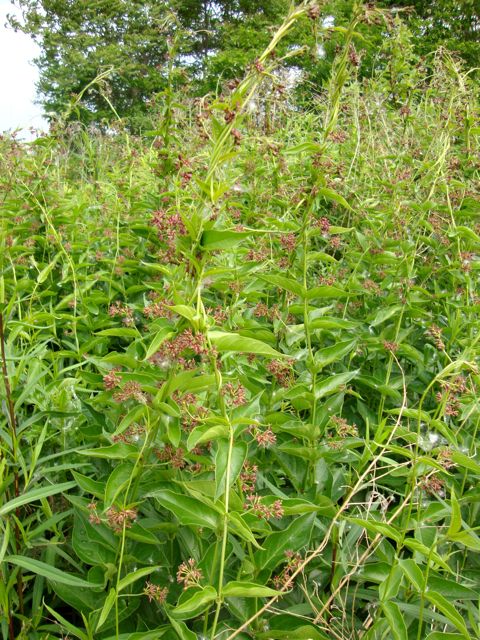If you haven’t nipped it in the bud yet, at least get this menace before it sets seeds.
The brownish flowers of dog-strangling vine aka swallowwort (Vincetoxicum rossicum, syn. Cynanchum spp., from the Greek meaning “to choke a dog”) usually look fairly insignificant, though they seem fairly showy in this picture. I guess this particular plant was ready for its closeup.
This alien visitor is taking over vast expanses of Toronto soil, and it has its eyes on your garden or your neighbour’s garden. In fact, it could already be there. I just cut off two upstarts in the garden next door.
Dog-strangling vine should be strenuously fought. For the past few years, I’ve waged a campaign to educate gardeners about this green plague.
Why fight it? First, it’s aggressively invasive, with extensive root systems, multiplying shoots and thousands and thousands of downy, airborne seeds. As this link shows, whole fields in the Don Valley now support nothing but dog-strangling vine.
As a cousin of milkweed, it also confuses Monarch butterflies, who can lay their eggs on the leaves where the hatchling caterpillars aren’t able to survive. Monarchs have had a tough time of it this year, their numbers significantly reduced by a series of unfortunate events in their over-wintering grounds. While it’s hard to do much about the disaster by the Don, let’s help them all we can in our own gardens.
Here’s what the shoots look like. Here’s what you do about them:
• Don’t yank up the vines. They have extensive, woody root systems. Pulling can cause the roots to break underground, and each half will send up new shoots.
• Cut the vines off at or below soil level, and keep cutting off any regrowth. Eventually, you’ll starve the root.
• You can dispose of non-flowering stems (but not roots) in the compost pile. Put flowers or juvenile seed pods in the green bin or garbage.
• Don’t let it go to seed. Seed production starts soon, beginning around the end of June. The seeds will look like narrow, milkweed-like pods (both are in the dogbane family)
Here’s the long view of the flowers. See how they start twining together at the tops. Shudder.





